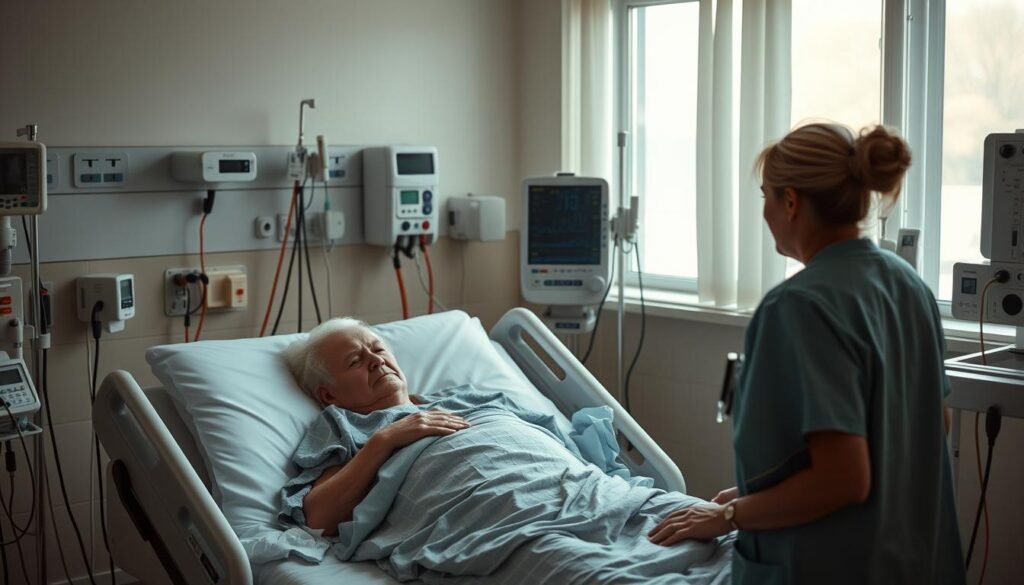Did you know that colorectal cancer patients being treated are usually around 70 years old? This fact highlights the crucial link between age and cancer treatment outcomes. It shows why understanding the effect of age is important in predicting survival and success rates of treatments. As more people live longer, it becomes urgent to know how aging affects cancer outcomes. This knowledge is key for doctors to give the best care to older patients.
Cancer mostly affects older adults, so it’s vital to create special treatment plans for them. The research shows that while the chance of surviving colorectal cancer might not change much with age, the overall chance of surviving decreases as people get older. This is important information for doctors when choosing treatment plans for older cancer patients.
Key Takeaways
- The average age for colorectal cancer resections is 70 years.
- Overall survival rates decrease significantly with increasing age.
- CRC-specific survival rates remain relatively unaffected by age.
- Aging populations necessitate tailored treatment strategies in geriatric oncology.
- Emergency resections show higher mortality rates, especially in older patients.
- Comorbidities significantly vary across different age groups.
Understanding Cancer Survival Rates
Cancer survival rates show how well patients do after treatment. They reveal the percent of patients living a certain time after diagnosis. The five-year mark is often used. Knowing these stats helps patients and families understand what’s ahead.
Many things affect these rates, like age, health, and cancer type. We use overall survival and prognosis to measure. Overall survival tells us the chance of living a certain time after finding the cancer. It considers death from any cause. This gives a broad view of patient outcomes.
Cancer prognosis, or net survival, looks at survival from cancer alone. It takes out other possible death causes. This shows how cancer affects life span. Relative survival compares cancer patients’ survival to those without cancer. It’s another key measure.
About 375,400 people get cancer each year in the UK. That’s close to 1,000 new cases every day. A lot of these are in older adults, with about 35% over 75.
Cancer survival rates are getting better over time. Better understanding of cancer helps doctors treat it more effectively. For more on cancer staging, check out TNM staging.
Factors Influencing Treatment Outcomes
Knowing what affects treatment results is key to understanding cancer care. Things like age, gender, and other health issues play a big role. These factors can change how well someone recovers during treatment. For instance, older people might struggle more because they already have health problems.
A study looked at 4,732 people with tuberculosis. The average age was 52.5, and 83.9% were treated successfully. But it was harder for older patients. People over 75 had a much lower chance of surviving.
Whether someone is male or female can also change their treatment results. In the tuberculosis study, women had better chances than men. They were less likely to stop treatment early or die. This is similar to what’s seen in cancer care, where women often have better outcomes.
Treatment success also depends on the method used, especially for older patients. For example, different chemotherapy treatments work better for certain age groups.
So, we can’t look at treatment results on their own. They’re connected to who the patients are and the treatments they get. As cancer care gets better, we need to keep these things in mind to help patients live longer, better lives.
Age-Related Factors in Cancer Prognosis
Age plays a key role in cancer outcomes, especially in older people. As we age, our body changes and may not handle cancer treatments well. Older patients also tend to have other health issues, making cancer treatment more complex. This affects their chances of survival.
In Sweden, out of 28,725 people with esophagogastric cancer, only 39.0% had surgery. The risk of dying increases with age. For example, people aged 65-69 have a death risk (HR) of 1.13 in five years. For those 85 and older, the risk jumps to 1.84. These numbers show how age seriously impacts cancer survival.
Age when diagnosed is crucial for cancer outcomes, like in breast cancer. Young women with certain breast cancers often do better. But younger women with triple-negative breast cancer have a worse outlook. This means we need specific treatment plans for older cancer patients.
It’s vital to understand how age affects cancer. By focusing on managing health issues in midlife, we might lower cancer risks as we get older. For more on age-related factors in cancer, check out this resource.
The Impact of Age on Survival Rates and Treatment Outcomes
Age is key when looking at survival and treatment results in older cancer patients. Older adults face unique issues with cancer care. They might react differently to treatments than younger people. Their treatment plans often change, impacting their survival chances. By understanding these differences, we can better care for older patients.
Exploring Geriatric Oncology
Geriatric oncology deals with cancer in older adults. It looks at their special needs and challenges. A large number of cancer patients are over 65. For instance, 68% of those with pancreatic cancer are in this group. This shows the importance of knowing how to treat older adults. Plus, statistics show that fewer people over 70 get full treatment.
Statistics on Survival Rates Across Age Groups
Survival trends change with age. Older patients often have worse health scores. For those with advanced pancreatic cancer, survival drops with age. People over 80 have a high 90-day mortality rate of 15.3%. This is compared to 9.4% for those 65-79 and 5.7% for patients under 65. These numbers show how age affects the risk after surgery and treatment success.
| Age Group | Percent of Patients Receiving Treatment | 90-Day Mortality Rate | Median Overall Survival |
|---|---|---|---|
| Under 65 | 55.5% | 5.7% | Higher OS |
| 65-79 | 33.0% | 9.4% | Moderate OS |
| 80 and older | 11.5% | 15.3% | Lower OS |

Colorectal Cancer and Age Discrepancies
Colorectal cancer (CRC) brings unique challenges, particularly for older patients. Age differences greatly impact treatment and outcomes. It’s vital to understand these differences to better care and boost survival rates.
Emergency vs. Elective Resections in Older Patients
Older patients undergoing surgery for colorectal cancer face higher risks. Compared to elective surgery, emergency surgery has more complications and higher death rates. Elective resections have fewer postoperative issues.
Emergency surgeries show the need for plans suited to older patients with health problems. The choice of surgery must consider age and how urgent the situation is.
Overall and CRC-Specific Survival Rates
Overall survival rates drop as patients get older, even if CRC-specific survival rates don’t vary much with age. Younger patients with metastatic CRC have a median survival of 27.07 months. Older patients have a slightly lower median survival of 26.12 months.
Younger patients have a progression-free survival of about 10.87 months. The older ones average about 10.55 months. This highlights the need for treatments tailored to the individual.
With colorectal cancer affecting younger people more, understanding survival rates is key. This disease may become a leading cause of death by 2040. For in-depth information on survival and age in CRC, click here.
Postoperative Complications in Elderly Patients
Postoperative issues are a big problem for older people getting cancer treatment. As they get older, the surgery risks go up, especially with cancer. Many studies show that older patients often face complications after surgery. These can be breathing problems or even more serious issues. They heavily impact recovery and chances of surviving.
Common Issues Faced by Older Cancer Patients
There’s some eye-opening data about older patients. For instance, 36.6% of patients 65 or older who had pancreatic surgery face challenges. They have more health problems besides cancer, about 62.6%, compared to younger ones at 32.4%. The issues after surgery are worse in older patients. There’s a 16.8% chance of serious problems, much higher than the 9.0% in younger folks.
The numbers also show a higher death rate after surgery for older patients, 5.5%, while it’s only 0.9% for the younger. Older patients often have worse health scores before surgery. Those 65 or older have a 1.63 times higher risk of running into serious problems afterwards. This highlights the need for surgeries that really suit older patients.
| Age Group | Severe Postoperative Complications (%) | Postoperative Mortality Rate (%) | Comorbidities (%) |
|---|---|---|---|
| 65 years and older | 16.8 | 5.5 | 62.6 |
| Under 65 years | 9.0 | 0.9 | 32.4 |
| 80 years and older | Not specified | 15.4 | Not specified |
| Under 80 years | Not specified | 2.0 | Not specified |
Older patients facing surgery need careful planning. Knowing how age and other health issues mix with surgery problems is key to better cancer care.

Age-Adjusted Outcomes and Treatment Strategies
Changing treatment plans based on a patient’s age and health helps make therapy more effective. Age matters a lot when figuring out the best treatment. Knowing how age affects treatment response improves survival and life quality, especially in older patients with complex health issues.
We need to look beyond just age. It’s about considering each person’s health condition and disease stage too.
Tailoring Therapies for Different Age Groups
Adjusting treatments like dosage and type is part of age-adjusted outcomes. For the elderly, especially cancer patients, it’s key to adjust treatment for their higher risk. Studies show that age-specific changes can improve cancer care and outcomes.
An age-focused approach uses study findings to lessen the impact on older patients. This understanding lets doctors create better care plans. It also lets patients make informed decisions about their treatment options.
| Age Group | Crude Mortality Rate | Age-Adjusted Mortality Rate | Treatment Strategy |
|---|---|---|---|
| 13% | 15% | Standard Chemotherapy | |
| 40-65 years | 20% | 18% | Targeted Therapy |
| 65-80 years | 28% | 25% | Combination Therapy |
| ≥80 years | 38% | 35% | Palliative Care Focus |
Age and Treatment Response
The link between age and how well cancer treatments work is key for older cancer patients. Studies focus on how these patients handle medicine differently. This is important because of their body changes and other health issues they may have.

Key Differences in Drug Efficacy by Age
Research shows a clear difference in how treatments work based on age. For example, patients younger than 55 often respond well to treatment, with success rates of about 40.3%. But, those 55 and older see a lower success rate, around 27.5%.
In higher risk cases, younger patients have a 74% chance of surviving their disease. Older patients, though, only have a 12% survival rate. This shows why it’s crucial to consider age when planning cancer treatments.
Patients over 60 face higher risks of dying and often get treatments that aren’t aimed at curing them. It’s vital to create treatment plans that address the unique challenges older patients face. By doing so, we can offer better, more compassionate care to those battling cancer in their later years.
For more details on these findings, you can visit the Netherlands Cancer Registry.
Long-Term Survival and Recurrence Rates
Long-term survival in cancer patients is crucial, with many factors affecting recurrence rates. Age is important in these outcomes. While older patients can have good survival rates, they may face more recurrences. This relationship shows we need to look more at how treatments change with age.
Trends in Long-Term Outcomes for Age Groups
Research shows how survival rates vary by age. The five-year disease-free survival rate is 57%. The overall survival rate is 89%. This shows the impact of treatments like chemotherapy, linked to better survival.
Cancer’s severity also affects survival. Advanced stages lead to more recurrences. Studies also found that less follow-up care can mean more recurrences. This highlights the need for careful post-treatment monitoring.
When it comes to age, treatment choices differ. People over 80 often choose less aggressive treatment than younger ones. As our population ages, it’s key to tailor treatments to these trends.
For triple-negative breast cancer survivors, there’s a 91% chance of no recurrence in 10 years. Yet, there’s still a risk later on for some cancers. Fortunately, survival rates after surgery don’t depend on age. This is vital in planning continuing treatment.
Patient care, especially for older adults, must focus on comprehensive follow-up and personalized treatments. This approach aims to reduce recurrences and improve survival. It shapes the future of cancer treatment and patient care.
Conclusion
The article makes it clear that age greatly affects how well people with cancer survive and respond to treatment. It shows a worrying trend. Older patients, especially those older than 65, often have lower survival rates. This drop is mainly caused by other illnesses they might have and the difficulties that come with being older.
This information stresses how important it is for doctors to pay close attention to each patient’s unique situation. When it comes to illnesses like colorectal cancer, older people are usually the ones who get diagnosed. This makes it critical for doctors to create treatments that meet the specific needs of older patients. Making treatments that match the patient’s age can really help improve their chances of getting better and their life quality.
As more people get older, we can’t ignore how age affects cancer treatment and chances of getting better. It’s essential to keep researching and understanding how age changes outcomes. Healthcare providers will be better prepared to fight cancer with this knowledge. They’ll make sure all patients get the care they need, no matter their age.